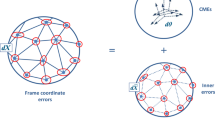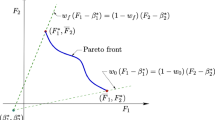Abstract
The multiple view geometry of static scenes is now well understood. Recently attention was turned to dynamic scenes where scene points may move while the cameras move. The triangulation of linear trajectories is now well handled. The case of quadratic trajectories also received some attention.
We present a complete generalization and address the problem of general trajectory triangulation of moving points from non-synchronized cameras. Two cases are considered: (i) the motion is captured in the images by tracking the moving point itself, (ii) the tangents of the motion only are extracted from the images.
The first case is based on a new representation (to computer vision) of curves (trajectories) where a curve is represented by a family of hypersurfaces in the projective space ℙ5. The second case is handled by considering the dual curve of the curve generated by the trajectory.
In both cases these representations of curves allow: (i) the triangulation of the trajectory of a moving point from non-synchronized sequences, (ii) the recovery of more standard representation of the whole trajectory, (iii) the computations of the set of positions of the moving point at each time instant an image was made.
Furthermore, theoretical considerations lead to a general theorem stipulating how many independent constraints a camera provides on the motion of the point. This number of constraint is a function of the camera motion.
On the computation front, in both cases the triangulation leads to equations where the unknowns appear linearly. Therefore the problem reduces to estimate a high-dimensional parameter in presence of heteroscedastic noise. Several method are tested.
Similar content being viewed by others
References
S. Avidan and A. Shashua, “Trajectory triangulation: 3D reconstruction of moving points from a monocular image sequence,” IEEE Transactions on Pattern Analysis and Machine Intelligence, Vol. 22, No. 4, pp. 348–357, 2000.
M. Barnabei, A. Brini, and G.C. Rota, “On the exterior calculus of invariant theory,” Journal of Algebra, Vol. 96, pp. 120–160, 1985.
B. Buchberger and F.Winkler, Gröbner Bases and Applications, Cambridge University Press, 1998.
D. Cox, J. Little, and D. O'Shea, Ideals, Varieties and Algorithms, 2nd., Springer-Verlag, 1996.
W. Chojnacki, M. Brooks, A. van den Hengel, and D. Gawley, “On the fitting of surfaces to data with covariances,” TIPAMI, Vol. 22, 2000.
J. Costeira and T. Kanade, “A multibody factorization method for independent moving objects.” International Journal of Computer Vision, Kluwer, Vol. 29, Sep. 1998.
D. Eisenbud, Commutative Algebra with a View Toward Algebraic Geometry, Springer-Verlag, 1995.
D. Eisenbud and J. Harris, The Geometry of Schemes, Springer-Verlag, 2000.
O.D. Faugeras and Q.T. Luong, The Geometry of Multiple Images, MIT Press, 2001.
W. Fulton, Algebraic Curves: An Introduction to Algebraic Geometry, Addison-Wesley Publishing Company: The Advanced Book Program.
A.W. Fitzgibbon and A. Zisserman, “Multibody structure and motion: 3D reconstruction of independently moving objects,” in Proceedings of European Conference on Computer Vision, June 2000, pp. 891–906.
M. Han and T. Kanade, “Reconstruction of a scene with multiple linearly moving points,” in Proceedings of IEEE Conference on Computer Vision and Pattern recognition, June 2000.
J. Harris, Algebraic Geometry, A First Course, Springer-Verlag, 1992.
R.I. Hartley and A. Zisserman, Multiple View Geometry in Computer Vision, Cambridge University Press, 2000.
R. Hartshorne, Algebraic Geometry, Springer-Verlag, 1977.
J.Y. Kaminski, M. Fryers, A. Shashua, and M. Teicher, “Multiple view geometry of non-planar algebraic curves,” in Proceedings of International Conference on Computer Vision, July 2001.
J.Y. Kaminski and M. Teicher, “General trajectory triangulation,” in Proceedings of European Conference on Computer Vision, June 2002.
S. Lang, Algebra, 3rd edn., Springer-Verlag, 2002.
R.A. Manning and C.R. Dyer, “Interpolating view and scene motion by dynamic view morphing,” in Proceedings of IEEE Conference on Computer Vision and Pattern Recognition, June 1999, pp. 388–394.
B. Matei and P. Meer, “A general method for errors-in-variables problems in computer vision,” in Proceedings of IEEE Conference on Computer Vision and Pattern recognition, 2000.
D. Segal and A. Shashua, “3D reconstruction from tangent-ofsight measurements of a moving object seen from a moving camera,” in Proceedings of European Conference on Computer Vision, June 2000, pp. 507–521.
A. Shashua and L. Wolf, “Homography tensors: On algebraic entities that represent three views of static or moving points,” in Proceedings of European Conference on Computer Vision, June 2000, pp. 507–521.
Y.Wexler and A. Shashua, “On the synthesis of dynamic scenes from reference view,” in Proceedings of IEEE Conference on Computer Vision and Pattern recognition, June 2000.
L. Wolf and A. Shashua, “On projection matrices ℙk → ℙ2, k= 3,..., 6, and their applications in computer vision,” in Proceedings of IEEE International Conference on Computer Vision, July 2001.
Author information
Authors and Affiliations
Rights and permissions
About this article
Cite this article
Kaminski, J.Y., Teicher, M. A General Framework for Trajectory Triangulation. Journal of Mathematical Imaging and Vision 21, 27–41 (2004). https://doi.org/10.1023/B:JMIV.0000026555.79056.b8
Issue Date:
DOI: https://doi.org/10.1023/B:JMIV.0000026555.79056.b8




